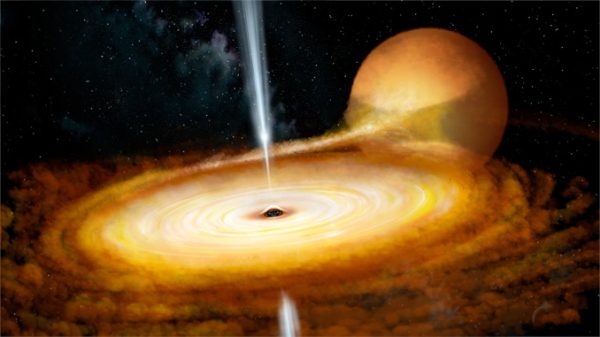Best view yet of flickering jets in black hole feeding frenzy – Astronomy Now Online

Astronomers have captured high-speed camera views of crackling millisecond flashes of light generated by debris being pulled into a relatively nearby black hole, violent flicker-like bursts of radiation equivalent to the energy of a hundred suns released “in the blink of an eye.”
The HiPERCAM instrument on the Gran Telescopio Canarias at La Palma in the Canary Islands and the X-ray-sensitive NICER instrument aboard the International Space Station gave an international team of astronomers led by the University of Southhampton a bird’s eye view of a black hole system known as MAXI J1820+070.
Located about 10,000 light years away, the black hole is believed to have a mass of about seven Suns crammed into a region smaller than the City of London. Gas from a nearby star, pulled into a rapidly spinning accretion disc, radiates visible light and X-rays as the material is heated to extreme temperatures.
Data HiPERCAM and NICER instruments were used to create a high frame-rate movie showing those high-speed changes in exquisite detail.
“The movie was made using real data, but slowed down to 1/10th of actual speed to allow the most rapid flares to be discerned by the human eye,” said John Paice, a graduate student at Southampton and lead author of the study. He also was the artist who created the dramatic movie.”
The above video is a visualization based on the observed visible and X-ray light emitted by the system, captured at more than 300 frames per second.
“We can see how the material around the black hole is so bright, it’s outshining the star that it is consuming, and the fastest flickers last only a few milliseconds,” Paice said. “That’s the output of a hundred Suns and more being emitted in the blink of an eye.”
The HiPERCAM and NICER data confirm earlier observations that drops in X-ray output are accompanied by increases in visible radiation, and vice versa, with the fastest visible flashes occurring a fraction of a second after X-rays. This behaviour has been seen in two other systems, but not at this level of detail.
“The fact that we now see this in three systems strengthens the idea that it is a unifying characteristic of such growing black holes,” said Poshak Gandhi of Southhampton, who found the other two examples. “If true, this must be telling us something fundamental about how plasma flows around black holes operate.
“Our best ideas invoke a deep connection between in-spiralling and out-flowing bits of the plasma,” he added. “But these are extreme physical conditions that we cannot replicate in Earth laboratories, and we don’t understand how nature manages this. Such data will be crucial for homing in on the correct theory.”






